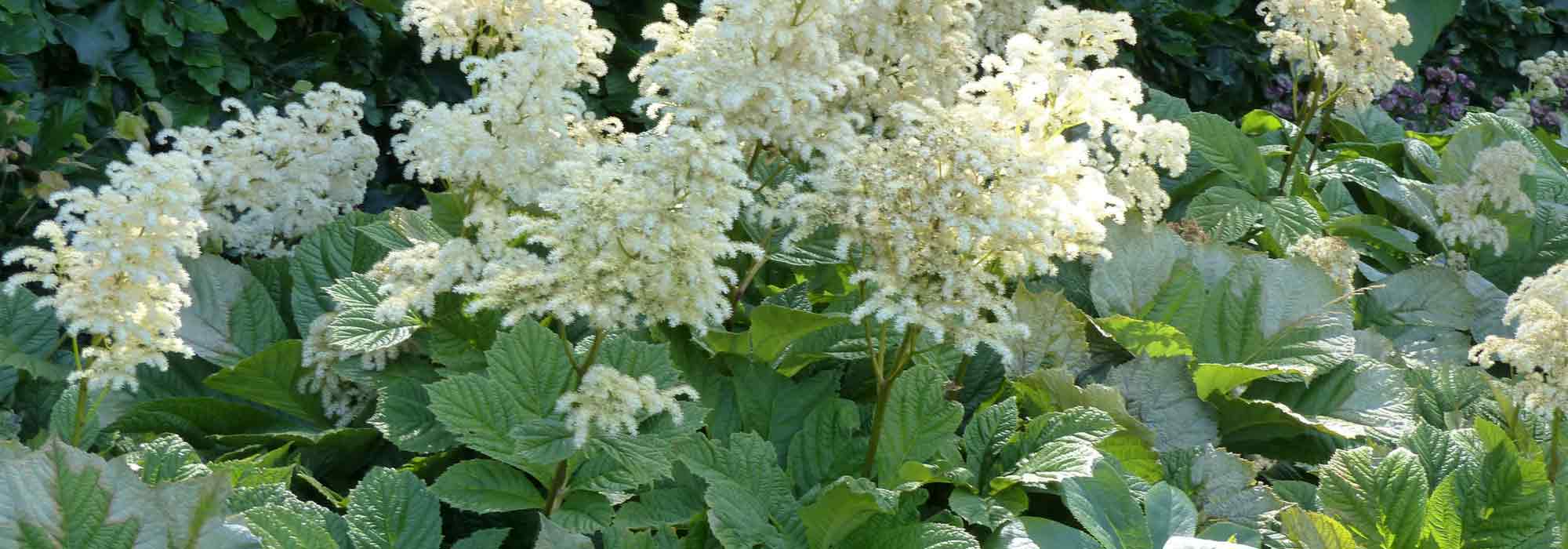
Rodgersia: planting, growing and care
Contents
Rodgersia in a nutshell
- With its very trendy “jungle” vibe, Rodgersia is a perennial star of cool, damp spots
- It bears lush foliage with large, very striking palmate leaves
- Its flowering in large, feathery white or pink inflorescences is remarkable
- Completely hardy and virtually disease-free, it grows in acidic soil rich in humus
- A particularly vigorous plant, perfect for cool, shaded corners of the garden or around water features
A word from our expert
Imposing, colossal, exotic, superlatives abound to describe the Rodgersia, this large, luxuriant perennial, a true star of cool to wet places!
As robust and as expansive as a hosta, it forms quite opulent clumps (up to 1.20 m) of large palmate leaves topped by airy flowering in white, pink or cream-yellow.
From Rodgersia aesculifolia with “horse-chestnut leaf”, to Rodgersia podophylla with chocolate-brown leaves turning green, to Rodgersia pinnata ‘Superba’ with bronze-green foliage, via cultivars ‘Bronze Peacock’ and ‘Chocolate Wings’ with leaves ranging from bronze-brown to intense red, not forgetting Rodgersia henrici with spring bronze-purple foliage turning dark green in summer, all are remarkable at water’s edge, in moist borders or in a bog garden.
This generous, feathery perennial favours deep, humus-bearing, acidic, cool soils and a situation in shade or sheltered from scorching sun.
Discover this majestic plant, imposing and particularly vigorous (hardy to -25°C), virtually disease-free, indispensable on pond banks, in cool soils and heather soil beds!
Description and botany
Botanical data
- Latin name Rodgersia
- Family Saxifragaceae
- Common name Rodgersia
- Flowering June to August
- Height 0.60 to 1.50 m
- Exposure Sun, partial shade
- Soil type Neutral, acidic, well-drained
- Hardiness -20°C to -25°C
Rodgersia is a perennial in family Saxifragaceae, native to humid, mountainous areas, fresh forests and copse in Burma, Korea, China and Japan. Plant has acclimatised to temperate gardens and parks.
Genus includes 6 species and numerous cultivars. Among those most widespread in our climates are Rodgersia aesculifolia, often called “Rodgersia with horse-chestnut leaves”, Rodgersia pinnata or “Rodgersia with pinnate leaves”, Rodgersia podophylla or “Rodgersia with duck’s-foot leaves”, Rodgersia sambucifolia or “Rodgersia with elder-like leaves”, and Rodgersia aesculifolia var. henrici, a natural variety of the horse-chestnut–leaved Rodgersia.
Rodgersia takes 3 to 5 years to establish well and reach full development. Plant develops slowly from fleshy, scaly, running rootstocks. It remains largely vegetative during first years, flowering generally occurring only after two years in cultivation. Its slow establishment is matched only by its longevity. Without being invasive, it gradually spreads to form stumps of more than 1 m² and slowly colonises the ground over time.
The plant has an architectural, bushy habit. Rodgersia forms a fairly dense, imposing clump that can reach 1.50 m in flower, with a 2 m spread.
Rodgersia is characterised by powerful, majestic vegetation. This deciduous foliage, particularly elegant and graphic, disappears completely in autumn at first frosts.
In spring, the fleshy stump produces a generous clump of large petiolate leaves, pinnate or more or less palmate, with margins more or less dentate. Leaves can reach 80 cm in length; they are divided into 3 to 11 large lanceolate, oblong or obovate leaflets.

Some foliage: Rodgersia pinnata, Rodgersia ‘Bronze Peacock’, Rodgersia podophylla (photo Megan Hansen-Flickr), Rodgersia pinnata ‘Dark Pokers’
Some forms have a wooly or rough aspect, others are glossy; most are crumpled or puckered and deeply veined. Foliage of Rodgersia pinnata strongly resembles that of horse-chestnuts, while foliage of Rodgersia podophylla is as palmate as a “duck’s foot”!
Green with brown-red veins in Rodgersia aesculifolia, bronze then dark green turning purple, red or orange in autumn in Rodgersia podophylla — hues of this ample palmate foliage vary according to species and varieties, sometimes changing through the seasons.

Foliage development of a Rodgersia podophylla: young dark purple leaves in spring, green in summer and red‑orange in autumn
What distinguishes form henrici of the type species Rodgersia aesculifolia is its young spring foliage, bronze‑purple at bud burst period, becoming dark green in summer.
Some cultivars of Rodgersia pinnata, such as ‘Bronze Peacock’ and ‘Chocolate Wings’, produce foliage that changes from bronze‑brown or chocolate brown to deep red before fading.
Summer flowering in large, cloud‑like panicles on tall, robust stems is often spectacular.
From early to late summer, plant sends up large, impressive spikes of flowers, sometimes carried up to 1.50 m above palmate foliage clumps. These large, branched, feathery inflorescences, 20 to 70 cm long, bear clusters of star‑shaped flowers in pure white, ivory or fresh pink to purplish‑pink, borne on sometimes reddish stems. They give way to dark red or brown capsule fruits of little decorative interest.

Some Rodgersia flowers: Rodgersia pinnata ‘Superba’ (photo Rob Bakker-Flickr), Rodgersia pinnata ‘Chocolate Wings’, Rodgersia aesculifolia ‘Irish Bronze’, ‘‘Rodgersia ‘Bronze Peacock’
These airy, graphic spikes make beautiful fresh summer bouquets in vases.
Despite its exotic appearance, Rodgersia shows good hardiness at least down to -25°C. It is a shade‑ and cool‑loving plant, ideal by water features or on edges of damp understorey where it brings an exotic luxuriance.
It favours cool, moist soils that retain water well, with a preference for non‑calcareous ground; a typically acidic or neutral understorey soil will suit it perfectly. It is an indispensable perennial for heavy soil. It will tolerate non‑scorching sun only if soil remains well moist at depth in summer.
Main species and varieties
Genus includes around ten recognised species and numerous cultivars of Rodgersia that are distinguished by the shape of their large palmate leaves and their sometimes changing colours through the seasons. Rodgersia aesculifolia bears large rounded leaves divided into dentate leaflets similar to those of horse chestnut, Rodgersia podophylla has foliage so palmate it evokes a duck’s foot, Rodgersia sambucifolia evokes elder leaves, while Rodgersia aesculifolia var. henrici is distinguished by horse chestnut‑style leaves of red‑bronze in spring, becoming dark green in summer. Rodgersia pinnata, with large pinnate, veined leaves, has given rise to cultivars notable for foliage leaning towards chocolate‑green such as ‘Bronze Peacock’ and ‘Chocolate Wings’, turning deep red late in season.
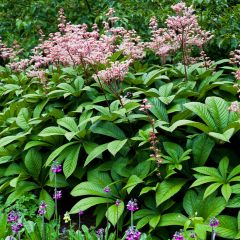
Rodgersia aesculifolia
- Flowering time September, October
- Height at maturity 1 m

Rodgersia podophylla
- Flowering time July, August
- Height at maturity 1 m

Rodgersia pinnata
- Flowering time July to September
- Height at maturity 1 m
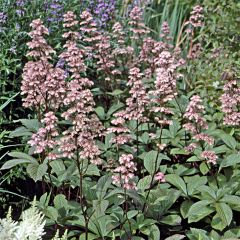
Rodgersia aesculifolia var. henrici
- Flowering time August, September
- Height at maturity 1,20 m
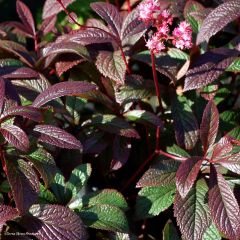
Rodgersia pinnata Bronze Peacock
- Flowering time July, August
- Height at maturity 50 cm

Rodgersia pinnata Chocolate Wings
- Flowering time August, September
- Height at maturity 1 m
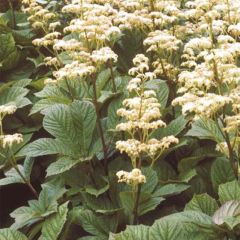
Rodgersia aesculifolia Irish Bronze
- Flowering time June, July
- Height at maturity 1 m
Discover other Rodgersia
View all →Available in 2 sizes
Available in 1 sizes
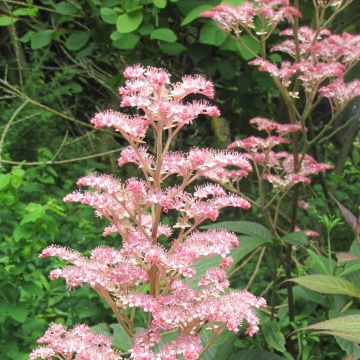
Available in 2 sizes
Available in 1 sizes
Available in 1 sizes
Available in 1 sizes
Available in 1 sizes
Available in 1 sizes
Available in 1 sizes
Available in 1 sizes
Planting
Where to plant Rodgersia?
Hardy, Rodgersia tolerates frosts down to -25 °C and thrives in all our cool, humid regions, particularly on the north-west coast of our country. Its culture can prove more difficult in Mediterranean climate that is too dry and hot in summer.
Its only requirement is moist soil; this plant does not tolerate lack of water and will wither in dry soil. Rodgersia does not like drought.
It prefers shade and cool conditions but will tolerate sun in temperate regions, provided the soil remains constantly moist and cool. However, site it sheltered from cold, dry winds and direct sun, which can damage its foliage.
Easy to grow, it will be most luxuriant and vigorous in soil rich in organic matter.
It typically prefers woodland soil, neutral or acidic, free of lime.
While it likes rather heavy soils that never completely dry out in summer, it does, however, fear excess water in winter; provide a perfectly drained soil.
Choose a well-exposed position to allow it to reach full size. This perennial is very impressive and slowly but surely forms quite opulent clumps up to 2 m in spread without ever becoming invasive despite its running rootstocks. Foliage becomes truly large when the plant is grown in a semi-shaded spot where ambient humidity is high in summer.
Rodgersia is at its best as an understorey plant, at water’s edge, on pond banks, where its luminous flowering and imposing palmate foliage will brighten the scene.
It will make a statement in beds of fresh heather soil, as a specimen or planted several along a shaded path.
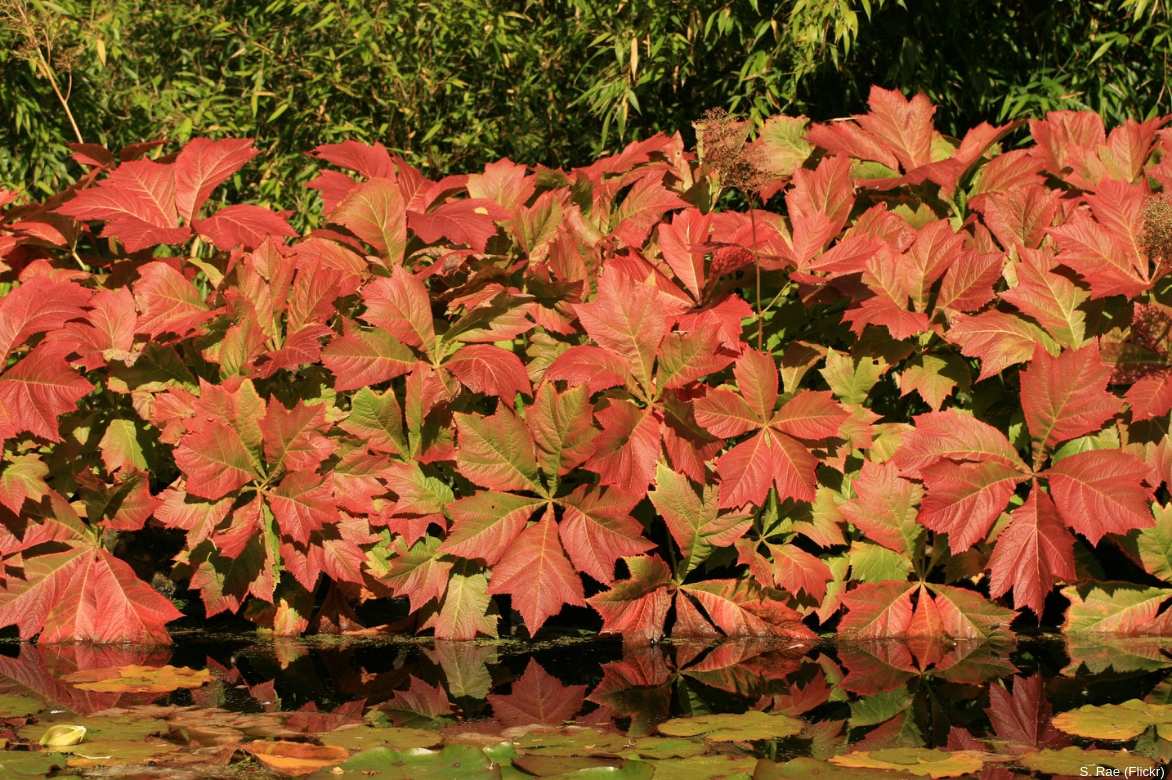
When to plant Rodgersias?
Rodgersias are planted in autumn (September–October) in temperate zones, or in spring from March to May in cold climates.
How to plant Rodgersia?
In open ground
Space plantings well: at ripeness, Rodgersia reaches a spread of 1 to 2 metres. Do not be fooled by its small size in the bucket!
Space plants at minimum 0.70 to 0.80 m apart in worked soil, loosened and enriched with well-rotted compost or manure.
- Dig a hole 2 to 3 times wider than the rootball
- Fork over the soil to 30–40 cm depth
- Spread a layer of gravel at the bottom of the planting hole
- Add a good shovelful of well-rotted compost or manure to the bottom of the hole before placing the rootball
- Bring soil back in to enclose the roots and firm down
- Water generously until establishment and throughout the first year after planting
- Mulch the base thoroughly at the end of May with an organic mulch to preserve moisture during summer
Planting Rodgersia in a pot
Despite the vigorous growth of this perennial, container culture is possible because Rodgersia roots are fairly shallow. However, the rootstocks can quickly try to escape their container: provide a large pot of at least 70 cm diameter.
- Plant the rootball in a mix of garden soil, clayey soil and enriched compost
- Place a good layer of gravel or expanded clay balls in the bottom of the pot beforehand to improve drainage
- Mulch
- Water very regularly; never allow the substrate to dry out
Care and maintenance
This plant is not fussy and will largely look after itself provided conditions suit it.
Le Rodgersia is a perennial that loves water. It creates large, exotic-style displays right up to frosts, but it must be watered, often and generously!
Coolness and moisture at its base are the secrets to to grow this colossal perennial! Soil must be kept sufficiently moist, otherwise it will quickly wither in prolonged drought. Fresh soil will allow vigorous growth.
Water very regularly during first year to ensure good establishment. Afterwards, only once a week, especially during hot spells.
Mulch in late May to reduce watering and evaporation. In very cold climate, mulch the stump with dead leaves in autumn; late frosts may damage young, still-tender shoots.
Every two years, in March, spread a few shovelfuls of compost over the stump.
Remove spent stems after flowering to encourage foliage development or leave them standing to dry for seed harvest.
Wait until spring to tidy the clump and remove withered leaves.
Divide stumps into chunks in March to ensure plant’s longevity.

Potential diseases and pests
Hardy and robust, Rodgersia has few enemies.
It is however sensitive to dry, cold winds and scorching sun and to slugs in spring, which can damage young shoots, though much less so than with hosta, its shade companion. Mechanical traps or an annual slug treatment from February are necessary. Try our natural methods!
Rodgersias grown in pots can be more susceptible, notably to vine weevil larvae that devour the roots… Watch for attacks by these small beetles that ‘punch’ holes in the edges of leaves: burn them, remove young plants that are too infested. Spray with tansy decoctions.
Multiplication
Sowing of Rodgersia is possible, but requires a great deal of patience. We recommend instead division of stumps in spring, in March. Only intervene after 4 or 5 years when plant is well established.
- Using a forked spade, lift part of the stump before foliage develops
- With a spade, slice off a good clump
- Replant clumps immediately in well-worked soil enriched with compost
Associating
A must in shaded gardens and at the water’s edge in marsh gardens, the Rodgersia with its imposing foliage of large palmate leaves and its pastel, plume-like inflorescences brightens cool areas.
At the edge of a cool, moist understorey, it is perfect with shade companions such as ferns, ligularias, Peltoboykinia, Cierge d’argent, Epimedium, filipendulas, heucheras or alongside Asian primulas or Begonia grandis evansiana.

An example of a combination: Hostas, Rodgersia podophylla, Catalpa bignonioides ‘Aurea’, flowering dogwoods (Le Sous-Bois, Belgium)
Classic Rodgersia partners, astilbes and Hostas enjoy the same growing conditions and will make a striking display in a cool, shaded border.
Among its top partners are also grasses (Carex, gardener’s rush, Japanese rush, tufted hairgrass).
At the edge of a pond, pair it with other perennials for damp margins such as Gunnera or Darmera, marsh euphorbias, Siberian irises, perennial lobelias.
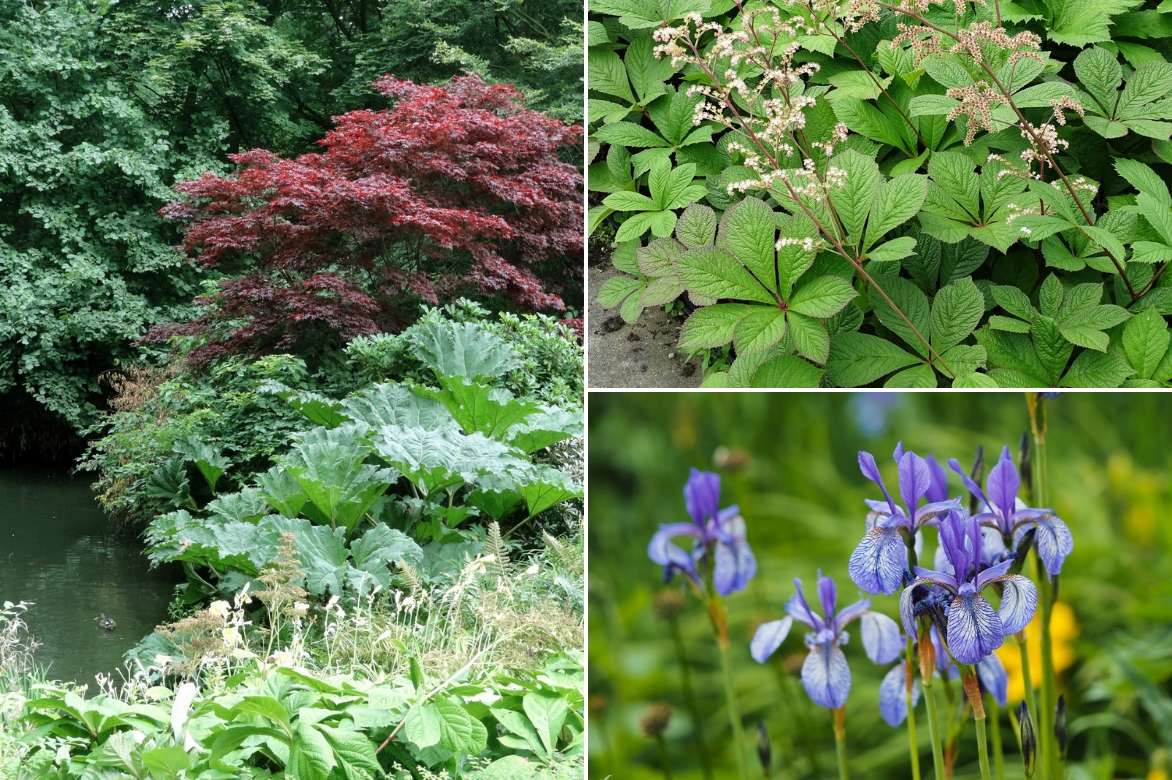
A planting idea at the edge of a pond: Gunnera tinctoria, Rodgersia pinnata ‘Hercule’ (R. pinnata or other species also work perfectly), Iris sibirica (‘Blue King’, ‘Caesar’s Brother’), ferns…
Rodgersia complements a border of bushes on heather soil such as rhododendrons.
To enhance the edge of a shaded path, set it off with a tapetum of groundcover polygonums, golden Sagina, candelabra primulas and hepatics.
Its handsome palmate leaves, often turning a reddish-bronze in autumn, fortunately harmonise with a wide range of trees and bushes with late colouring such as maples, barberries and deciduous euonymus, smoke trees, sumachs and grasses with autumnal hues.
Useful resources
-
- Lush Rodgersia fits perfectly into an exotic, otherworldly garden — get inspiration from our ideas! inspiration ideas
- Find companion plants for shade gardens to go with your Rodgersia
- Take Michaël’s tips to create a bold, graphic bed for cool shade
- Also check out our article on slow-establishing plants
- Subscribe!
- Contents

































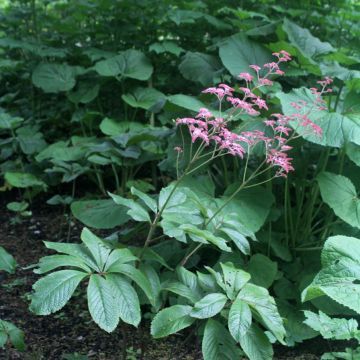
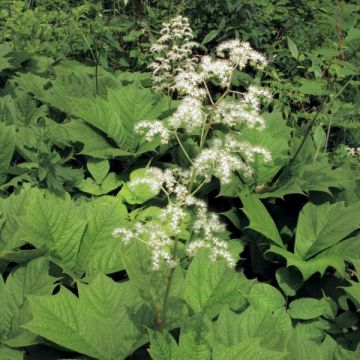
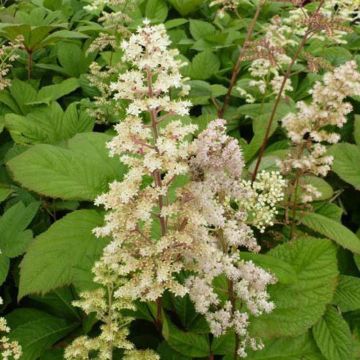

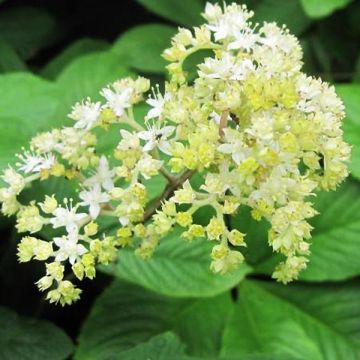
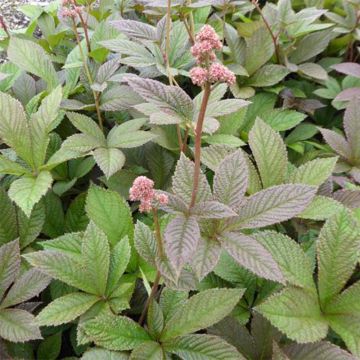
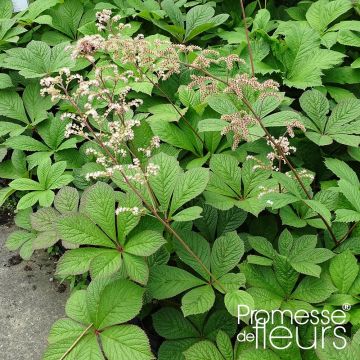

Comments